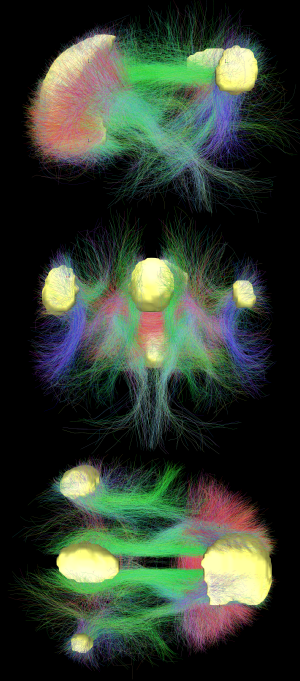用户:Johnbook1911/预设模式回路
| 预设模式回路(DMN) | |
|---|---|
 功能性磁振造影显示大脑中预设模式回路的区域
| |

在神经科学中,预设模式回路(DMN)是一个与大脑各区块有高度交互作用的大范围回路。
预设模式回路是当人不将注意力放在外在的世界时,大脑就会处在清醒的休息状态,例如做白日梦或发呆时。人在想著自己或他人,回忆往事或计画著将来时,预设模式回路也是会处在活跃的状态。也就是当人放空的时候,预设模式回路就会自然启动。人在处理一些有目地的任务时,预设模式回路是关闭的,所以预设模式回路也被当成是反任务的回路,但当这些任务是与人际关系或自身生活经验相关时,预设模式回路就会被再次启动。预设模式回路与注意力网路是呈现负相关的,也就是注意力提高时,预设模式回路的活跃程度就会降低。
已经有证据显示阿兹海默症与自闭症是因为预设模式回路的缺陷引发的。
作用
编辑已知预设模式回路有数个不同的作用:
本回路是“自我认知”的神经系统基础:
- 自我的资讯:与自我相关的人生记忆
- 自我的参考:对于自我的特征与描述
- 自我的情绪:反映出自我的情绪状态
当想到他人时:
- 心智的原理:当顾虑到他人时,想到他人知道或不知道
- 他人的情绪:了解他人的情绪,与感同身受的作用
- 道德的判断:决定对或错
- 人际的评估:对于人际关系上的好或坏
- 人际的分类:对于人际群体特性的判断
回忆过去与计画未来:
- 回忆过去:回溯陈年往事
- 想像未来:对于未来的展望与计画
- 情节记忆:对于过去事件的细节记忆
- 故事理解:记得并了解故事的描述
本回路在被动的休息状态与发呆时会启动,人在发呆时通常就会想到其他人,想到自己,回忆过去与放眼未来。脑波图的研究显示,本回路在人结束手上工作的当下就会立刻开始活跃。
研究发现当人在看电影、听故事时,他们的预设模式回路会高度地与其它回路交互作用。当人不了解故事的内容时,预设模式回路就不会开始交互作用,也就是本回路与故事的理解与故事的记忆呈现高度的相关。在故事的讲者换了人,或以不同的语言来讲述时,也还是会与本回路有关联。进一步的研究显示,本回路与故事本身的理解力有关,而不是故事的讲者,或故事所使用的语言。
本回路在执行有目标性的外部工作时,是关闭的,例如:专注看著某样东西,或使用记忆力来工作时,有部分研究人员将本回路认定是反任务的回路。但如果一个有目标性的外部工作是本回路所负责的话,例如:社交行为的记忆,或与自身生活经验相关的工作,本回路就会呈现正相关,并且与其他回路交互作用,例如:负责决策行为的回路。
Raichle coined the term "default mode" in 2001 to describe resting state brain function;[1] the concept rapidly became a central theme in neuroscience.[2] Around this time the idea was implanted that this network of brain areas is involved in internally directed thoughts and is suspended during specific goal-directed behaviors. In 2003, Greicius and colleagues examined resting state fMRI scans and looked at how correlated different sections in the brain are to each other and found the correlation maps showed the same areas Raichle found active during rest and that others found to deactivated.[3] It was important because it demonstrated a convergence of methods all lead to the same areas being involved in the DMN. Since then other resting state networks (RSNs) have been found, such as visual, auditory, and attention networks, some of them are often anti-correlated with the default mode network.[4]
- ^ Raichle, M. E.; MacLeod, A. M.; Snyder, A. Z.; Powers, W. J.; Gusnard, D. A.; Shulman, G. L. Inaugural Article: A default mode of brain function. Proceedings of the National Academy of Sciences. 2001, 98 (2): 676–82. PMC 14647 . PMID 11209064. doi:10.1073/pnas.98.2.676.
- ^ Raichle, Marcus E.; Snyder, Abraham Z. A default mode of brain function: A brief history of an evolving idea. NeuroImage. 2007, 37 (4): 1083–90. PMID 17719799. doi:10.1016/j.neuroimage.2007.02.041.
- ^ 引用错误:没有为名为
:4的参考文献提供内容 - ^ Llinas, Samantha J.; Demanuele, Charmaine; Debener, Stefan; Helps, Suzannah K.; James, Christopher J.; Sonuga-Barke, Edmund J. S. Default-mode brain dysfunction in mental disorders: A systematic review. Neuroscience & Biobehavioral Reviews. 2009, 33 (3): 320. PMC 4219458 . PMID 18824195. doi:10.1016/j.neubiorev.2008.09.002.
|pages=和|page=只需其一 (帮助)|pages=和|page=只需其一 (帮助)
参考文献
编辑[[Category:注意力]] [[Category:认知神经科学]]